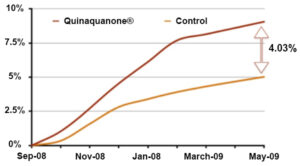- Bone density development was assessed using RBAE in 26 2-year-old thoroughbred racehorses in the same stable
- The treatment group received 7mg/water soluble VK1 (QAQ) per day, while the control group received a placebo blank powder
- The trial was carried out over 8 months
There was a greater increase of bone density in the treatment group compared to the control group
Trial 1 shows marked increases in bone density in two-year-old racehorses who were treated with Quinaquanone®
Twenty-six, two-year-old thoroughbred racehorses, at the beginning of race training, were divided into two groups.
One group (Quinaquanone®) received 7mg formulation each day in their feed for eight months. The other group (“Control”) received an apparently identical powder containing no Vitamin K1.
Digital radiographs of the left third metacarpal bone and an adjacent aluminum step wedge were taken at various intervals. The radiographic density of the bone and the step wedge were measured and RBAE (radiographic bone aluminum equivalence) calculated. At each subsequent measurement the RBAE for each horse was compared to its initial RBAE and the percentage change recorded.


| Date | 09/12/2008 | 10/14/2008 | 12/31/2008 | 02/02/2009 | 05/08/2009 |
| Vitamin K | 0 | 1.04±0.31 | 4.54±0.75 | 7.68±1.67 | 9.05±0.91 |
| Control | 0 | 0.35±0.71 | 2.82±2.97 | 3.97±2.83 | 5.02±2.17 |
Bone Density Trail in Two Year Old Racehorses
Mean percentage change in RBAE over time

Percentage change of radiographically measured bone density of 26 racehorses over eight months

